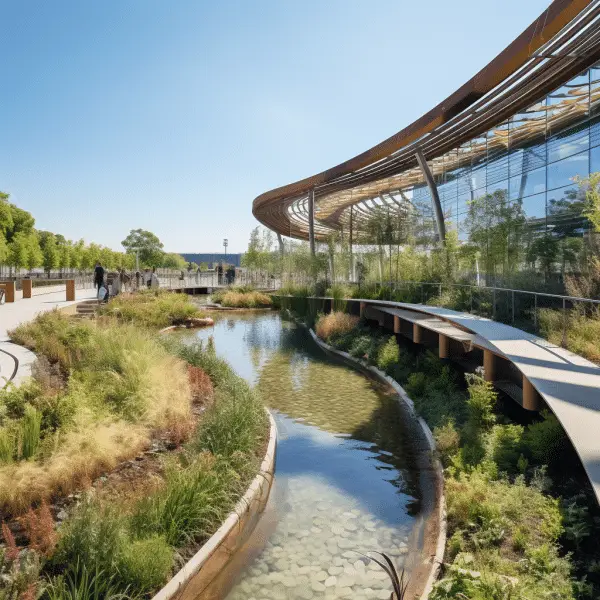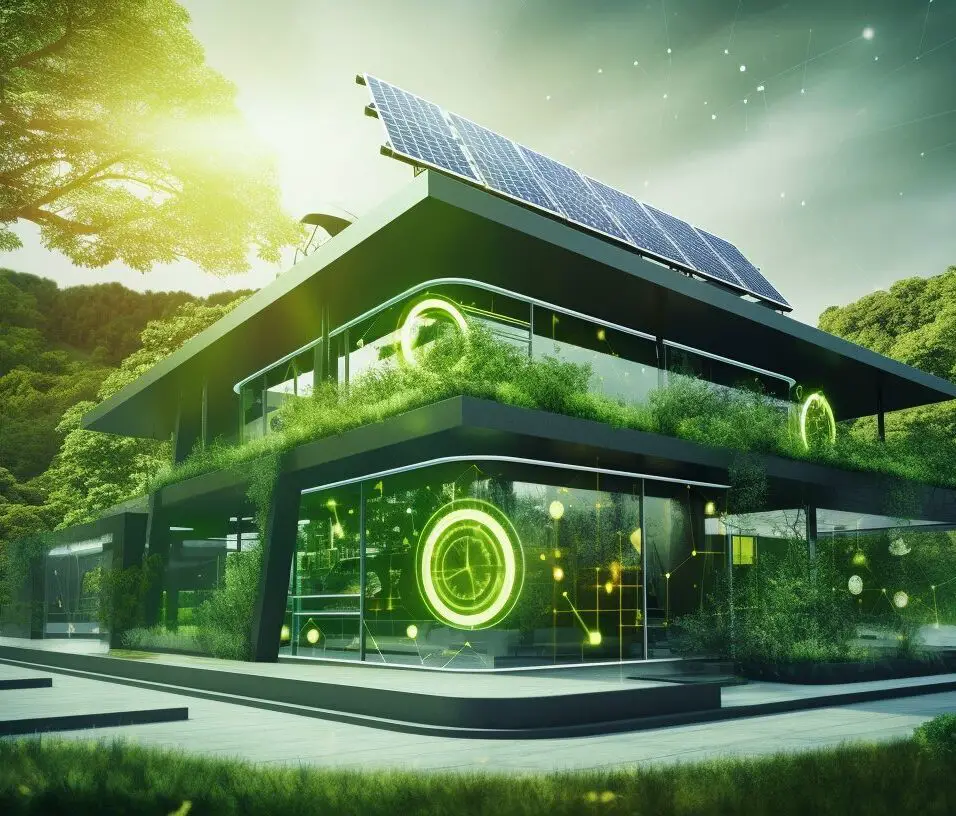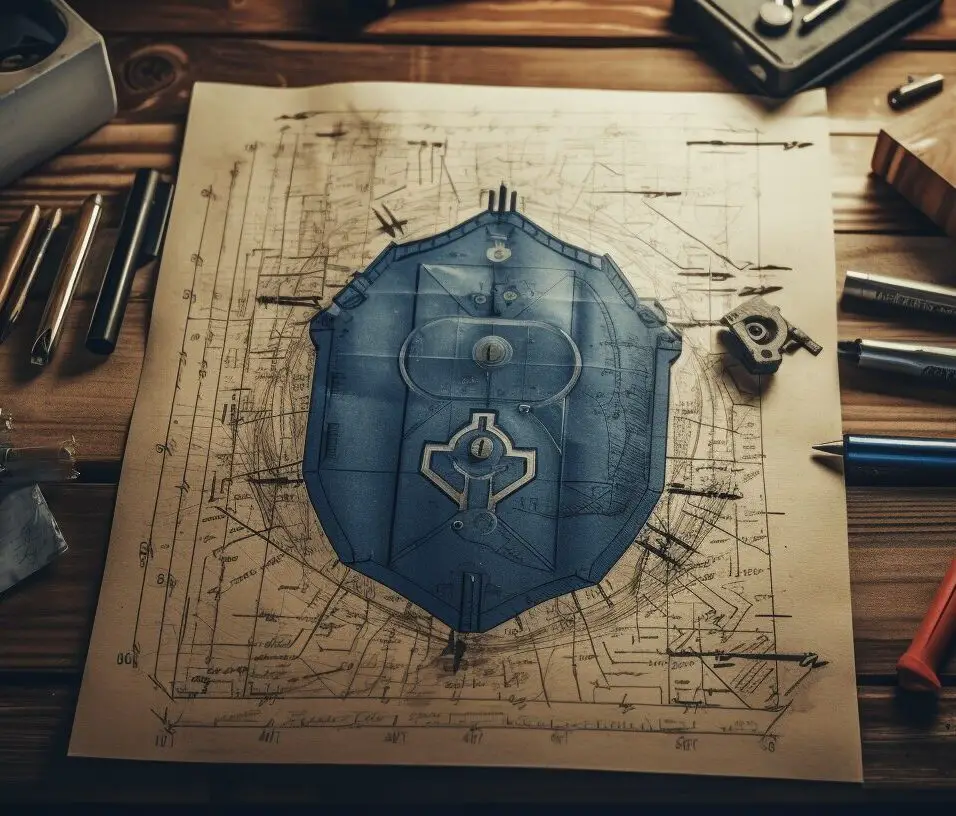How to design for water conservation?
Designing for water conservation is crucial in today’s world to reduce unnecessary water usage and promote sustainability. By implementing strategies and technologies that focus on water efficiency, designers can make a significant impact in conserving our planet’s most precious resource. In this section, we will explore the importance of designing for water conservation and the strategies that can be implemented to achieve this goal.
Key Takeaways
- Designing for water conservation helps reduce unnecessary water usage and promote sustainability.
- Strategies for water-conservation design include limiting turf areas, amending soils with organic material, and mulching planting beds.
- Rain gardens, runoff water capture, and the use of native and drought-resistant plants are also effective water conservation strategies.
- Responsible irrigation and efficient watering practices play a crucial role in water-conservation design.
- Additional measures, such as water-efficient landscaping and installing water-efficient toilets, contribute to water conservation efforts.
By following these strategies, designers can create landscapes that are not only aesthetically pleasing but also environmentally responsible, helping to conserve water and reduce water pollution. Stay tuned to learn more about the role of design in water conservation and the specific strategies that can be utilized.
The Role of Design in Water Conservation
Design plays a crucial role in water conservation, as it allows us to create innovative solutions that help preserve our planet’s most precious resource. By incorporating water-conservation design strategies into our landscapes, we can reduce unnecessary water usage and promote water efficiency. This not only benefits the environment but also helps us to create aesthetically pleasing and sustainable spaces.
One key practice in water-conservation design is limiting turf areas. Turf grass requires large amounts of water to maintain, so by reducing the amount of turf in our landscapes and replacing it with native plants or alternative ground covers, we can significantly decrease water consumption. Another effective strategy is to amend soils with organic material and use mulching in planting beds. These practices improve soil structure, retain moisture, and reduce the need for frequent watering.
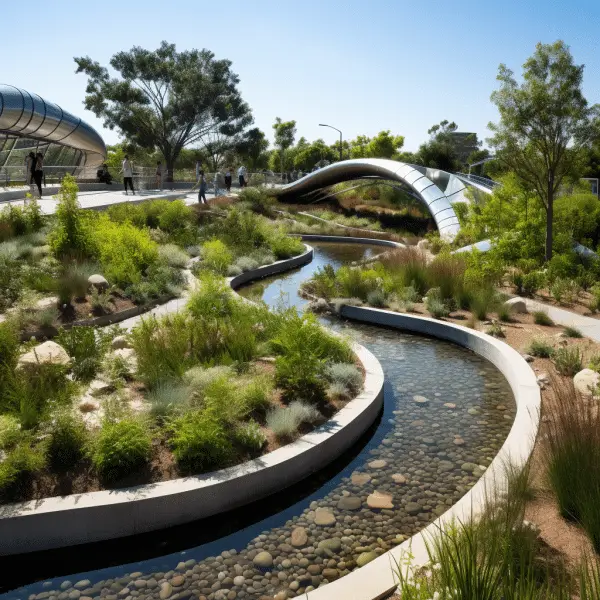
In water-conservation design, capturing and reusing runoff water is an essential technique. By incorporating rain gardens and implementing systems to collect and store runoff water, we can not only conserve water but also prevent water pollution by reducing stormwater runoff.
Native and drought-resistant plants
Using native and drought-resistant plants is another important aspect of water-conservation design. These plants are naturally adapted to local climate conditions and require minimal watering once established. By grouping plants according to their water needs, we can create efficient irrigation zones and avoid overwatering or underwatering. This ensures that plants receive the right amount of water, reducing waste and promoting their healthy growth.
Responsible irrigation and watering practices are also crucial in water-conservation design. This includes using irrigation systems that minimize water loss through evaporation or runoff, such as drip irrigation or targeted sprinklers. Additionally, covering pools when not in use and reducing the frequency of pressure washing can further conserve water.
Finally, water-conservation design involves implementing additional measures such as water-efficient landscaping, installing water-efficient toilets and urinals, and conducting regular leak detection and repair. Public information and education programs play a significant role in raising awareness about water conservation and encouraging behavior change.
| Key Strategies for Water-Conservation Design | Benefits |
|---|---|
| Limiting turf areas | Reduces water consumption |
| Amending soils with organic material and mulching | Improves soil moisture retention and structure |
| Capturing and reusing runoff water | Conserves water and prevents water pollution |
| Using native and drought-resistant plants | Requires minimal watering and promotes efficient irrigation |
| Implementing responsible irrigation and watering practices | Minimizes water loss and maximizes efficiency |
| Additional measures such as water-efficient landscaping, water-efficient toilets, and leak detection and repair | Contributes to overall water conservation efforts |
Strategies for Water-Conservation Design
There are various strategies that can be employed in water-conservation design to harness innovation and create sustainable solutions. By incorporating these strategies, designers can play a crucial role in promoting water efficiency and conservation. Some of the key practices include:
- Limiting Turf Areas: One effective strategy is to reduce the amount of turf areas in landscape design. Turf requires significant amounts of water to maintain, so by limiting its use and replacing it with alternative ground covers, water consumption can be significantly reduced.
- Soil Amendments and Mulching: Another essential practice is amending soils with organic material and mulching planting beds. This helps to improve soil structure and water retention, reducing the need for excessive irrigation. Mulching also helps to regulate soil temperature, prevent weed growth, and reduce water evaporation from the soil surface.
- Rain Gardens and Runoff Water: Rain gardens offer an innovative approach to water-conservation design. These specially designed areas collect and store rainwater, reducing runoff and allowing for its gradual infiltration into the soil. By capturing and reusing runoff water, designers can reduce the demand on freshwater supplies while promoting the growth of native plants adapted to the local climate.
- Native and Drought-Resistant Plants: Using native and drought-resistant plants in landscape design is an effective strategy for water conservation. These plants are adapted to local conditions and require less water to thrive. Additionally, grouping plants according to their water needs allows for more efficient irrigation, as plants with similar water requirements can be grouped together.
By implementing responsible irrigation and watering practices, designers can further enhance water-conservation efforts. This includes watering plants at the right time of day to minimize water loss through evaporation, using drip irrigation systems for targeted watering, and regularly monitoring and adjusting irrigation schedules to match plant needs.
Table: Water-Conservation Strategies and their Benefits
| Strategy | Benefits |
|---|---|
| Limiting Turf Areas | – Reduces water consumption – Lowers maintenance requirements – Promotes water efficiency |
| Soil Amendments and Mulching | – Improves soil structure and water retention – Regulates soil temperature – Suppresses weed growth – Reduces water evaporation |
| Rain Gardens and Runoff Water | – Collects and stores rainwater – Reduces runoff and promotes infiltration – Conserves freshwater resources – Supports native plant growth |
| Native and Drought-Resistant Plants | – Requires less water – Adapted to local climate – Efficient irrigation planning – Conserves water resources |
Furthermore, there are additional measures that can be incorporated into water-conservation design, such as covering pools to prevent water evaporation, reducing the frequency of pressure washing, and implementing water-efficient fixtures and appliances. Public information and education programs, distribution system audits, and leak detection and repair initiatives are also crucial in promoting water conservation.
Designing for water conservation is not only environmentally responsible but also contributes to the long-term sustainability of our precious water resources. By implementing these strategies and embracing innovation, designers have the power to create landscapes that are both aesthetically pleasing and environmentally conscious.
Limiting Turf Areas
Limiting lawn areas optimizes water usage and enhances water efficiency in water-conservation design. By eliminating turf grass, landscape designers can save water without sacrificing aesthetics. Hardscaping, native plantings, and groundcovers can add texture and visual appeal without using much water.
Designers can enhance irrigation efficiency by properly selecting turf areas like play areas and high-visibility zones. Designers can also reduce water wastage by combining plants with comparable water needs for targeted irrigation. This conserves water and lets vegetable gardens and delicate crops acquire more resources.
By minimizing mowing and maintenance, restricting turf areas can save water. Environmental pollution is caused by landfilling grass clippings and other turf waste. Designers may reduce turf to create beautiful, environmentally friendly landscapes.
| Benefits of Limiting Turf Areas |
|---|
| Optimizes water usage |
| Reduces water consumption |
| Decreases the need for mowing and maintenance |
| Minimizes water waste |
| Reduces environmental pollution |
Water-conservation design relies on designers to optimize water usage and increase water efficiency. Limiting lawn saves water use, upkeep, and pollutants. Designers can build water-conserving, attractive landscapes by using alternative landscaping features and grouping plants by water demands.
Soil Amendments and Mulching
Water-conservation design requires soil amendments and mulching to increase soil health, reduce evaporation, and conserve water. By adding compost or shredded leaves to the soil, designers can help it retain moisture and save watering. Organic matter also promotes soil microbial activity, which supports plant growth.
Mulching is another important water-saving method. Designers can reduce water evaporation, weed growth, and soil warmth by mulching using wood chips or straw. Mulch protects soil from direct sunlight and wind, which can dry it out. This maintains soil moisture and reduces irrigation.
When applying soil additives and mulching, consider plant water demands and local climate. Plants need varying water levels, thus grouping them might save water. Designers can avoid overwatering and underwatering by combining plants with comparable water needs for targeted irrigation and water waste reduction.
| Benefits of Soil Amendments and Mulching in Water-Conservation Design | |
|---|---|
| Improves soil health | Organic matter enriches the soil and promotes beneficial microbial activity. |
| Reduces evaporation | Mulch acts as a protective barrier, minimizing water loss from the soil surface. |
| Conserves water | Enhanced soil moisture retention reduces the need for frequent watering. |
In conclusion, soil amendments and mulching are vital components of water-conservation design. By implementing these practices, designers can improve soil health, reduce evaporation, and conserve water. By focusing on sustainable solutions like these, we can create landscapes that not only thrive aesthetically but also contribute to the preservation of our planet’s most precious resource.
Rain Gardens and Runoff Water
Rain gardens and the capture and reuse of runoff water are effective strategies in water-conservation design, ensuring sustainable water usage and promoting the growth of native plants. These innovative approaches not only help conserve water but also reduce the strain on municipal water supplies and prevent water pollution.
When it rains, rooftops, driveways, and other impermeable surfaces can cause excessive runoff, carrying pollutants into nearby water sources. Rain gardens, which are shallow basins filled with native plants, help capture and filter this runoff. The plants and soil in the rain garden act as natural filters, removing pollutants and allowing water to slowly infiltrate into the ground. This process not only replenishes groundwater levels but also reduces the risk of flooding by decreasing the amount of water flowing into storm drains.
By incorporating native plants into rain gardens, designers can further enhance water conservation efforts. Native plants are well-adapted to local climate conditions and require less water compared to non-native species. They also provide habitat for local wildlife and contribute to the overall biodiversity of the area. Additionally, grouping plants in rain gardens based on their water needs helps optimize water usage and minimize waste.
Benefits of Rain Gardens and Runoff Water
- Reduce water pollution by filtering runoff and removing pollutants.
- Replenish groundwater levels by allowing water to infiltrate into the soil.
- Minimize the risk of flooding by reducing stormwater runoff.
- Promote the growth of native plants and enhance biodiversity.
- Optimize water usage by grouping plants with similar water needs.
In conclusion, rain gardens and the capture of runoff water are valuable elements of water-conservation design. They not only help conserve water but also contribute to a more sustainable and resilient environment. By incorporating these strategies into landscape design projects, designers can make a significant impact on water conservation efforts and promote the use of native plants in their communities.
| Key Benefits | How It Works |
|---|---|
| Reduce water pollution | Filters runoff and removes pollutants |
| Replenish groundwater levels | Allows water to infiltrate into the soil |
| Minimize flood risk | Reduces stormwater runoff |
| Promote native plant growth | Enhances biodiversity and habitat |
| Optimize water usage | Group plants with similar water needs |
Native and Drought-Resistant Plants
Incorporating native and drought-resistant plants in water-conservation design is crucial, as they require less water and contribute to a balanced ecosystem when grouped according to their water needs. By selecting plants that are well-suited to the local climate and soil conditions, designers can create landscapes that are both resilient and water-efficient.
One effective strategy is to group plants with similar water requirements together. This allows for more efficient irrigation and reduces water waste. For example, plants that thrive in arid environments, such as succulents and cacti, can be grouped together in a dry garden. Similarly, plants that prefer moist soil, such as ferns and hostas, can be placed in a separate area that receives more water.
Another advantage of incorporating native plants is their ability to adapt to local conditions. These plants have evolved to withstand the region’s specific climate, including periods of drought. As a result, they require less supplemental watering and are more likely to thrive even in challenging conditions.
| Native Plants | Drought-Resistant Plants |
|---|---|
| California Lilac | Lavender |
| Manzanita | Sage |
| California Poppy | Agave |
| Yarrow | Yucca |
When choosing native and drought-resistant plants, it is important to consider their maintenance requirements as well. Opting for low-maintenance varieties can reduce the need for frequent watering, fertilization, and pest management. This not only saves water but also minimizes the use of chemicals that can harm the environment.
In conclusion, incorporating native and drought-resistant plants in water-conservation design is a sustainable and environmentally responsible choice. By grouping plants according to their water needs and selecting species that are well-adapted to the local climate, designers can create beautiful landscapes that conserve water and support a diverse ecosystem.
Responsible Irrigation and Watering
Water-conservation design requires responsible irrigation and watering to use water efficiently and sustainably. Designers may significantly reduce water wastage and promote eco-friendly landscaping by following these strategies.
Limited usage of automatic sprinkler systems and focused watering are viable strategies. Drip irrigation systems send water straight to plant roots, avoiding evaporation and maximizing every drop. This strategy saves water use and improves plant growth by distributing moisture where it’s needed.
Responsible watering includes setting a timetable depending on the landscape’s demands. Designers can choose watering frequency and duration according on soil type, plant species, and weather. Without overwatering, plants receive enough water without root rot and other problems.
Designers can also advise clients to cover pools to decrease evaporation and reduce pressure washing. These simple steps can significantly reduce water usage and waste.
Responsible irrigation and watering promotes water saving and landscape sustainability. These ideas can help designers build beautiful, eco-friendly outdoor environments using water-conservation design.
Table 1: Water-Saving Strategies
| Strategy | Description |
|---|---|
| Drip Irrigation | Delivers water directly to plant roots, minimizing evaporation. |
| Targeted Watering | Establishes a proper watering schedule based on specific landscape needs. |
| Covering Pools | Prevents water evaporation from pools. |
| Reducing Pressure Washing | Minimizes water usage by pressure washing less frequently. |
Additional Measures for Water Conservation
In addition to the aforementioned strategies, water-conservation design can encompass water-efficient landscaping, the installation of water-efficient toilets, and the implementation of leak detection and repair programs. These measures play a crucial role in reducing water waste and promoting sustainable water usage in various settings.
Water-Efficient Landscaping
Water-efficient landscaping involves designing and maintaining outdoor spaces in a way that minimizes water consumption. By choosing native or drought-resistant plants, grouping plants with similar water needs, and implementing efficient irrigation systems, designers can create landscapes that thrive while using less water. Additionally, utilizing mulch in planting beds helps to retain moisture, reducing the need for frequent watering.
| Benefits of Water-Efficient Landscaping |
|---|
| • Reduces water consumption |
| • Enhances plant health and resilience |
| • Saves time and money on maintenance |
| • Supports biodiversity and ecosystem health |
Water-Efficient Toilets
Installing water-efficient toilets is another effective measure in water-conservation design. High-efficiency toilets use less water per flush compared to traditional models, reducing water usage without compromising performance. These toilets often incorporate innovative flushing mechanisms and dual-flush options, allowing users to choose the appropriate water volume for different needs.
“Water-efficient toilets are a simple and practical solution to conserve water, making a significant impact on overall water consumption.”
Leak Detection and Repair Programs
Leak detection and repair programs are crucial in identifying and fixing water leaks promptly. Even minor leaks can lead to substantial water waste over time. By implementing regular inspections and maintenance schedules, designers can ensure that any leaks in plumbing systems, irrigation systems, or outdoor fixtures are promptly repaired, preventing unnecessary water loss.
“Efficient leak detection and repair programs are essential to prevent water wastage and maintain water efficiency in both residential and commercial settings.”
By incorporating water-efficient landscaping, installing water-efficient toilets, and implementing leak detection and repair programs, designers can make a significant impact in conserving water resources. These additional measures, combined with the previously discussed strategies, contribute to creating environmentally responsible spaces that promote sustainability and minimize water pollution.
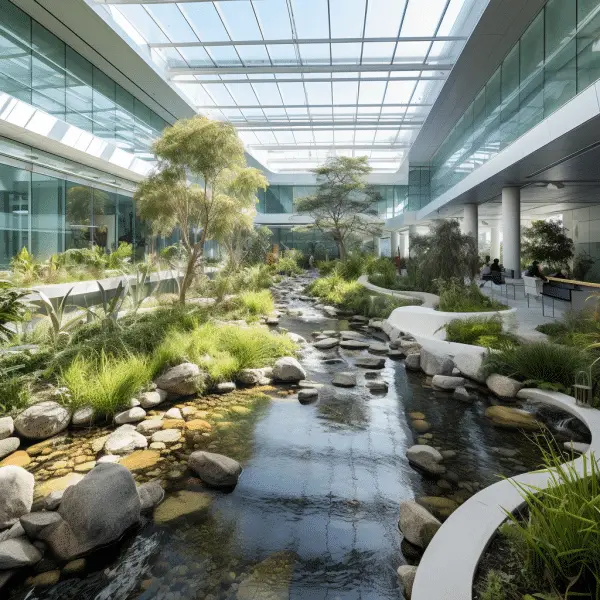
Conclusion
Sustainable living requires water conservation design to conserve water and reduce water pollution. Designers can reduce water waste and increase efficiency by using several methods.
Limiting turf, enriching soils with organic material, and mulching planting beds are important strategies. These methods help soil retain moisture, lowering water use. Installing rain gardens and catching runoff water conserves water and filters contaminants before they enter natural water systems.
Landscape water usage is reduced by using native and drought-resistant plants and arranging them by water needs. Conservation is also achieved by using drip irrigation systems and watering during cooler hours.
Individuals should also reduce pressure washing and cover pools to decrease water evaporation. Water conservation and pollution reduction can be achieved through public information and education initiatives, distribution system audits, leak detection and repair, water-efficient landscaping, and water-efficient toilets and urinals.
Designers may build beautiful, eco-friendly landscapes using these methods. Together, we can conserve water and protect the earth for future generations.
FAQ
Q: What is water-conservation design?
A: Water-conservation design involves implementing strategies and technologies to reduce unnecessary water usage and promote water efficiency in landscaping and other design projects.
Q: Why is designing for water conservation important?
A: Designing for water conservation is important because it helps conserve water, reduce water pollution, and promotes sustainable use of our planet’s most precious resource.
Q: What are some strategies for water-conservation design?
A: Some strategies for water-conservation design include limiting turf areas, amending soils with organic material, mulching planting beds, implementing rain gardens, capturing and reusing runoff water, using native and drought-resistant plants, grouping plants according to their water needs, responsible irrigation and watering, and installing water-efficient fixtures and appliances.
Q: How can limiting turf areas contribute to water conservation?
A: Limiting turf areas reduces the amount of water needed for irrigation and promotes water efficiency in landscaping. It also reduces the use of chemical fertilizers and pesticides, which can be harmful to water quality.
Q: What is the importance of soil amendments and mulching in water-conservation design?
A: Soil amendments and mulching help improve soil quality, retain moisture, and reduce evaporation, resulting in reduced water needs for plants. Organic material and mulching also contribute to healthier plant growth and reduced weed growth.
Q: How can rain gardens and the capture of runoff water contribute to water conservation?
A: Rain gardens can help absorb rainwater and prevent runoff, reducing the amount of water that needs to be supplied through irrigation. Capturing and reusing runoff water also decreases reliance on potable water sources.
Q: Why are native and drought-resistant plants important in water-conservation design?
A: Native and drought-resistant plants are adapted to local environmental conditions and have lower water requirements. By using these plants and grouping them according to their water needs, water usage can be optimized and waste minimized.
Q: What are responsible irrigation and watering practices in water-conservation design?
A: Responsible irrigation and watering practices involve using efficient irrigation systems, such as drip irrigation, and watering plants at appropriate times and in appropriate quantities to minimize water loss and promote water efficiency.
Q: What are some additional measures for water conservation in water-conservation design?
A: Additional measures for water conservation in water-conservation design include implementing water-efficient landscaping, installing water-efficient toilets and urinals, conducting distribution system audits, detecting and repairing leaks, and educating the public about water conservation.



